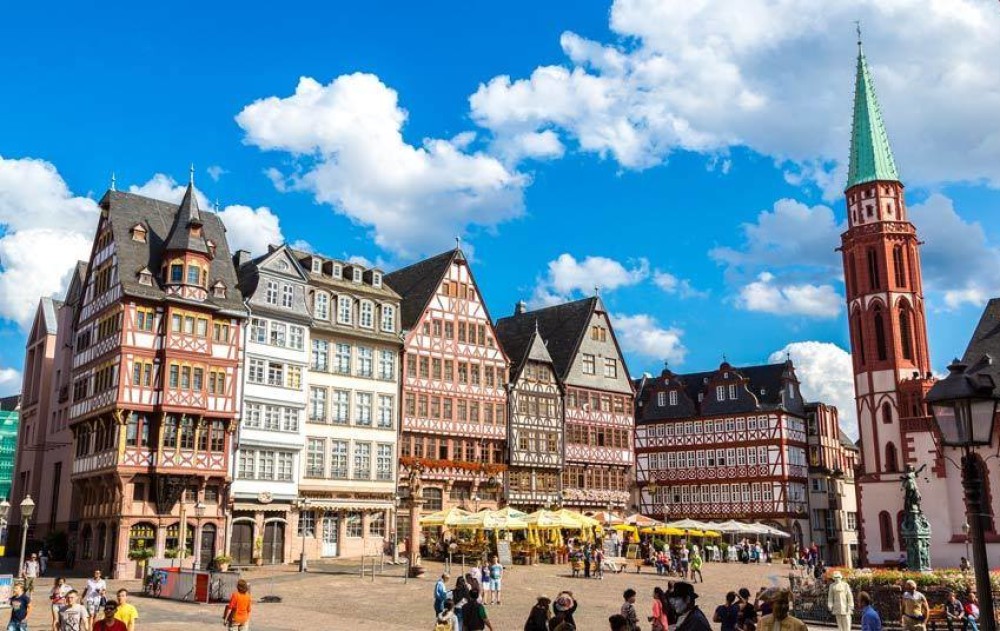Tucked amongst the rolling green vineyards at the foot of Northeastern France’s Vosges Mountains, a collection of immaculately preserved little villages hide five centuries’ worth of history and expert wine making in their colorful Renaissance-era half-timbers. Dotting Alsace’s rural Route du Vin—the loop that ties together some of France’s best vineyards—marvelously authentic villages like Riquewihr, Kayserberg, Eguisheim, and Hunawihr have happily defied the onslaught of time.
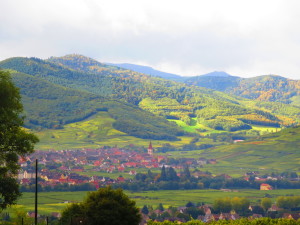
village in rural Alsace, France
Long beloved by wine enthusiasts and vacationing French, the cobble-stoned hamlets have become known to tourists worldwide who flock to soak up the authentic old-world cuteness—and sample their excellent vino.
The almost perfect preservation of the villages is in itself a minor miracle. The region, not far from the French-German border, has for centuries found itself the object of a tug-of-war by Europe’s two great imperial powers. The Germans believed their rightful territory extended to the mountains, while the French considered the Rhine to be the natural border. The picturesque territory—with its mellow Alsatian plain spilling out from the Vosges Mountains and renowned for its grapes since Roman times—was tussled over by diplomats and kings from the early middle ages onward.
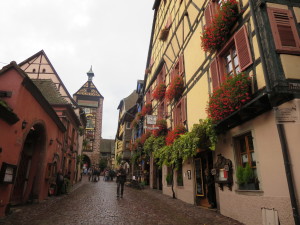
As a result of centuries of boarder-moving depending on which country had won the latest struggle, the region developed a fascinating hybridized culture. It was reflected in the language (Alsatian is a peculiar dialect) and the cuisine (the savory French dishes carries elements of the hearty Germanic fare). It’s not usual to see street signs bearing both a French and a German name; most of the signs date from the time when their national affiliation was constantly in flux. The residents of the villages, many of them vintners, consider themselves Alsatian first and Frenchmen—or occasionally Germans—a distant second.
Despite the political drama, the region prospered during a medieval boom in its wine industry. The resulting wealth led to many of the beautiful structures that stand today. The photogenic villages—crammed with wine shops, galleries, bakeries and stay-a-while cafés—look similar but have their subtle differences.
Tiny Kayserberg boasts a historic hometown hero—Nobel Prize winner Dr. Albert Schweitzer, famous for his humanitarian efforts in Africa, was born here in 1875. In addition to the notable local, the town also has an ancient church holding a historic 1518 altarpiece. Its proximity to the vineyard-blanketed hills and a looming castle in the hills makes it popular with the hiking set.
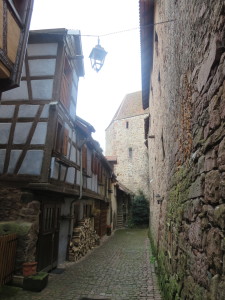
A little further along the winding Route du Vin is the cute-as-can-be hamlet of Eguisheim. The closest village to regional city Colmar, Eguisheim’s Hansel-and-Gretel aesthetic exerts a powerful pull on romantics. The collection of brightly painted medieval houses—some more charmingly ramshackle than others—make meandering down its winding alleyways a treat.
Hunawihr has a gorgeous Renaissance-era church in addition to its collection of cute half-timbered dwellings. Riquewihr is another gem. Boasting a magnificent medieval bell tower, a museum and fine cafés, it crams historic and culinary treats into its confines.
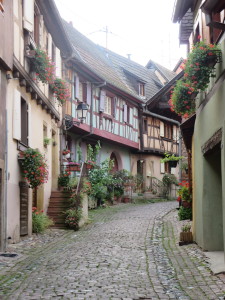
That is not to say the area was untouched by the tumult of the twentieth century. In fact, the region so used to being a political pawn found itself as the battleground in a profoundly important military event. As the New Years’ Day 1945 glowed pink at sunrise, German forces unleashed a surprise attack in the Vosges Mountains, sweeping down into the sleeping Alsatian plain. The region’s villagers were unknowingly in the middle of Operation Nordwind, Hitler’s last offensive of World War Two.
Ferocious fighting ensued over the course of several weeks in subzero temperatures. Allied and German vehicles alike became bogged down in the snow and mud while savage combat tore apart ancient towns like Bennwihr. In the sorts of random twists of fate that occur in war, the villages of Riquewihr, Kayserberg, Eguisheim, and Hunawihr were left unscathed while unlucky Bennwihr was almost completely destroyed by the dueling armies.
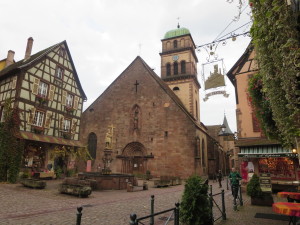
Despite the early pummeling, the Allies rallied and by February had reclaimed the vineyards, villages and mountains from the Germans. The failed offensive decimated much of Hitler’s remaining forces, and the Allies penetrated Germany not long after. Once again quiet settled upon the region and the villagers went back to making their wine as they had for centuries. Post-war tourists discovered the area’s charm and the resulting boon encouraged locals to keep their communities just as previous generations had—clean and quaint.
Now the villages welcome wine enthusiasts and romantics alike to be enchanted by their cobbled lanes, medieval wine cellars, and colorful Renaissance houses. Sample some of the local product and wander the winding back alleys with your camera before lounging at a café. The villages are full of hardworking folks who are happy to share their little slice of history with any traveler interested enough to seek it out.
